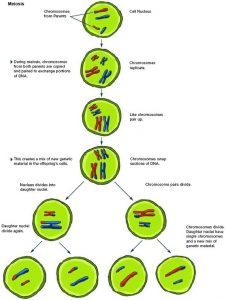Sexual reproduction is the creation of a new organism from a male and female. It requires the gamete (sperm cell) of a male, and the stationary gamete (Ovum or eggs) of a female to mix and create a new organism. The different cells are created in the testes for men and ovaries for women. After the cells mix the fetus begins to develop and the fetus is created. It will take 9 months for the fetus to fully develop and then it is born.
The different cells are created in the testes for men and ovaries for women. After the cells mix the fetus begins to develop and the fetus is created. It will take 9 months for the fetus to fully develop and then it is born.
Asexual reproduction is the creation of an organism without a mate. There are different forms of asexual reproduction: Bacteria and Binary Fission with a lot of animals and organisms, Fragmentation, Budding, Parthenogenesis, and vegetation propagation. These are all different forms of asexual reproduction. They all function in different ways but they are all similar.
Next up was mitosis and meiosis, we learned about what they were and the differences between them. Mitosis is cell division to create multiple cells. There are six steps to mitosis Interphase, the first phase where the functions are normal, but its replicating DNA, Prophase where the chromatins condense to chromosomes, Metaphase, the chromosomes attach to the spindle fibres, Anaphase, The  chromosomes move away from each other. Telophase is when the nuclei split and it gets ready for cytokinesis. Cytokinesis is when the cells finally split and the daughter cell is formed.
chromosomes move away from each other. Telophase is when the nuclei split and it gets ready for cytokinesis. Cytokinesis is when the cells finally split and the daughter cell is formed.
 Meiosis is similar to mitosis but is during sexual reproduction. They each share the same steps but meiosis has double. the first cell can produce up to four gamete cells, the process is required to create egg and sperm cells for sexual reproduction.
Meiosis is similar to mitosis but is during sexual reproduction. They each share the same steps but meiosis has double. the first cell can produce up to four gamete cells, the process is required to create egg and sperm cells for sexual reproduction.
We had a gallery walk of the stages in the development of organisms, Mating, Internal fertilization, pollination, and embryonic development. all the different stages are all with different organisms like Snakes, or Bees, or Humans etc.